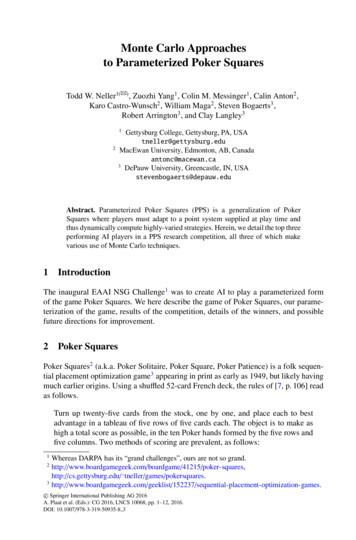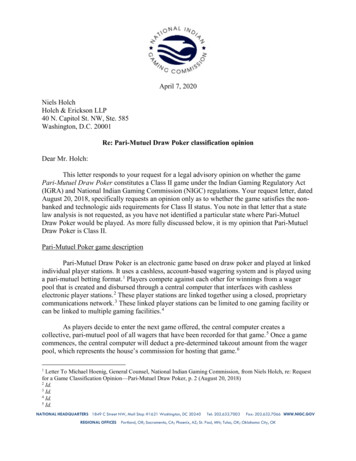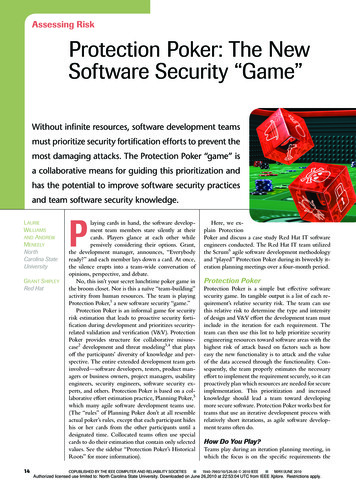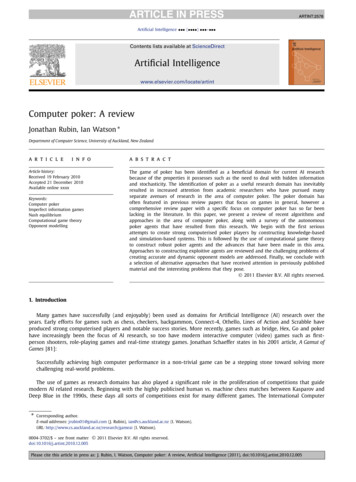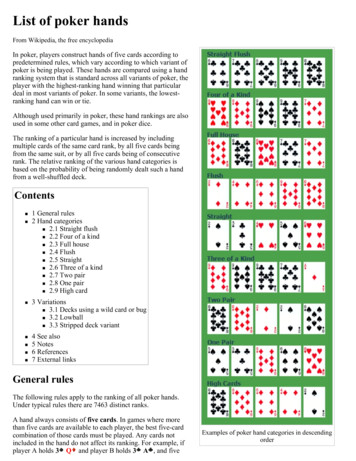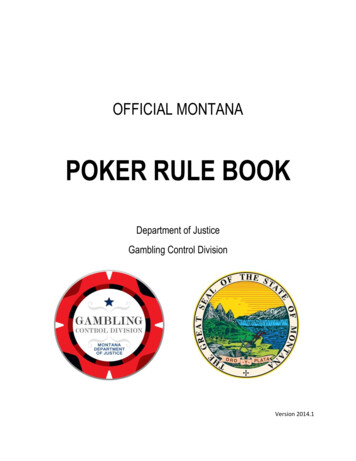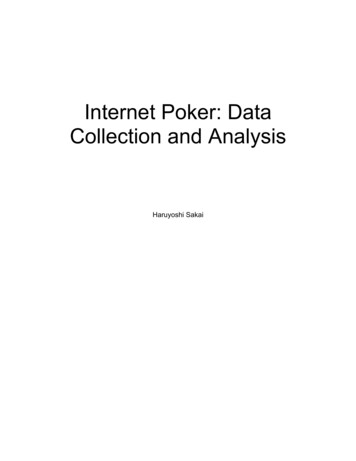
Transcription
Internet Poker: DataCollection and AnalysisHaruyoshi Sakai
Table of ContentsACKNOWLEDGEMENTS .4ABSTRACT .5DATA COLLECTION.71.Introduction72.Data Collection Methods83.a)b)4.Screen Capturing Primitives9Simple Image Matching . 9Trie Based Image Matching . 9Text Recognition5.13a)b)c)Game Element Parsing15Text Fields. 15Graphical Fields . 16Card Fields . 17a)b)c)d)Game Parsing18Pre-betting Action . 18Betting Action . 20Pot resolution . 22Overall Hand Parsing . 24a)b)The Query Environment: Main Components25Player . 25Game . 25a)b)c)d)e)f)g)h)i)The Query Environment: Secondary components26GameHeader. 26Roster . 26RosterEntry . 26RoundTranscript. 27Action. 27Results. 27PokerHand. 27Outcome . 28DataSet . 286.7.8.9.Sample Query2910.Lessons learned3011.Future Directions31DATA ANALYSIS: BETTING HABITS.321.Introduction322
2.a)b)Average Normalized Pot Size33Data . 33Analysis. 36a)b)Betting Round Statistics38Data . 38Analysis. 40a)b)Player bet size as a proportion of the current pot41Data . 41Analysis. 443.4.5.Conclusion46DATA ANALYSIS: DESCRIPTIVE DATA.471.Introduction472.Hand Occurrences473.Winningest and Losingest Players484.Hand with largest pot49CLOSING .513
AcknowledgementsMy thanks go out to John Jannotti for his help throughout this process.4
AbstractIn the past few years, there has been a massive boom in the popularity of pokeras an American pastime. While there has always been interest in poker in theUnited States, the game was propelled into the limelight due in no small part tothe aptly named Chris Moneymaker, an accountant from Tennessee. In 2003,Moneymaker rose to the top of a then all-time high field of 800 players andclaimed the first place purse of the World Series of Poker main event, raking in acool 2.5 million. While the standard buy-in for the main event of the WorldSeries is 10,000, Moneymaker managed to turn an initial investment of 39dollars into 2.5 million by winning a satellite tournament on the Internet pokerroom, PokerStars. Since then, poker has experienced an explosion in popularity.The field of the 2004 WSOP swelled to approximately 2,500 players, and thisyear’s event is expected to be even larger. Internet poker has seen a similarexplosion of popularity. As I write (at 2 in the morning), PokerStars has 20,070players at 3511 separate virtual tables with average pot sizes ranging from apaltry .25 to 625. With the ever-growing number of players, and everincreasing money stakes, Internet poker presents a large number interestingproblems.In Internet poker, it pays to have as much data as possible. A player with a largedatabase of hands often has a huge advantage playing against others. However,while most Internet poker sites allow you access to the hands in which youparticipated, they usually do not allow you access to hands in which you did nottake part. Moreover, the hand histories that one can obtain from the online pokersites are uneven in quality, some omit important information such as player chipstacks, and to my knowledge none include temporal information, that is, how longa player took to act. In the following, I present my method for automaticallytranscribing player hands, along with a presentation of some statistics from mycorpus of 64,000 hands of Texas Hold’em.5
Opening RemarksThe most popular variation of poker that is played today is undoubtedlyTexas Hold’em, specifically No Limit Texas Hold’em. For that reason, Ichose to focus on this particular poker variation. All of my data was collectedat No Limit tables, and all my remarks pertain specifically to No Limit (thoughthey are probably true elsewhere as well). In this thesis, I assume a workingknowledge of the rules of No Limit Hold’em, and a familiarity with basic pokerterminology. If you are unfamiliar with Hold’em, I direct you to the appendix,where you will find some references to familiarize you with the basics as wellas a glossary of the terms I use.6
Data Collection1. Introduction4213Figure 1: The PokerStars interfaceAll Internet poker applications have a large number of commonalities in theirinterfaces. This thesis takes the PokerStars interface (see Figure 1) as arepresentative of the standard GUI. Each table has some fixed number ofvirtual seats (9 in this case), which users can choose to occupy (we see anunoccupied seat (1) at the bottom of the table). When a seat is occupied, theplayer’s name, stack (2), and user icon are displayed. We also see a simpletext console (3), which is used for chat, as well as announcements of variousgame events. Lastly is the table itself, which is where the community cards(4) are dealt. From these elements, the user is able to discern all informationthat is relevant to the current state of the game. This user interface is alsothe entry point through which I chose to extract all hand data.7
2. Data Collection MethodsWhen approaching the problem of accumulating hand data, there arethree different approaches that lend themselves:1. Sniffing packet traffic between the poker client and server.2. Taking advantage of provided hand history facilities.3. Scraping the screen to obtain game information.Each of these approaches has its own drawbacks. Option 1 presents anumber of technical difficulties. First, the task of reverse engineering thepacket format would be tedious and time consuming. Second, and moreimportantly, the traffic between the client and server is securely encrypted.While in theory, it should be possible to determine the encryption key throughstudious examination of local binaries, in practice this would be extremelydifficult, and probably illegal. Moreover, the packet format and encryptionschemes would vary between poker programs, severely restricting thegeneral applicability of any code I produced.Similar considerations apply to using application native hand historyfacilities. As noted previously, support for hand histories is uneven. Someprograms do not provide them, and those that do make use of differingformats. The means for accessing these histories are similarly varied. TheGUI access points differ, as do the formats in which these histories aretransmitted; some are sent by email, others are saved as local text files.This leaves the final approach: performing screen captures. While there isbound to be a number of application specific elements (i.e. fonts, elementpositions, card faces, etc.), the general form of the GUI shares the commonelements of player seats, board cards, and chat window. In addition, bynecessity, a screen scraper has full access to all relevant game information.After all, if the screen scraper could not see it, the human players would notbe able to either.8
3. Screen Capturing PrimitivesIn order to create screen captures on the fly, I resorted to the built-in Javalibrary, Robot1. This class allows for real time screen capturing as well assimulated user input (which could be useful for future extensions). Thisfacility allows for the creation of simple image recognition primitives: simpleimage matching and prefix based foreground recognition.a) Simple Image MatchingThis operation is as simple as it sounds, it involves a pixel by pixelcomparison between two images. In pseudocode:ExactMatch(image 1, image 2)Input: Two imagesOutput: True if the images are pixel by pixel matches,false otherwisefor(x 0; x image 1.width; x ) {for(y 0; y image 1.height; y ) {if(image 1[x][y] image 2[x][y]) {return false;}}}return true;This method gives a quick and easy method of performing a directcomparison between two passed images.2 However, if we wish to makea comparison between a target image and a collection of comparisonimages, this method is inefficient, especially as the number ofcomparison images grows.b) Trie Based Image MatchingTo perform proper text recognition one needs to compare screenimages against all possible characters. While it is simple to java/awt/Robot.htmlNote that the image comparison is only affected by the size of the first image, if the second image is larger,it can still match.29
this using simple image matching, the running time becomes unwieldyas the number of images increases. In order to optimize the runningtime when comparing a source image against a large number ofcandidate images, it becomes necessary to use a prefix trie. While triesare commonly used in string matching applications, a simplegeneralization allows us to apply the trie technique for image matching.Given the library of images to compare against, we select a color to actas a relevant, or foreground color. After this foreground color is selected,we treat the candidate images as strings with length equal to the pixelwidth of the image. The K-th “character” of these image stringscorresponds to the number of foreground pixels in the K-th column of thecandidate image.Figure 2: The 'T' corresponds to the string 1,1,1,10,10,1,1,1Once the trie is constructed, in order to find the matching image, wesimply have to traverse the tree, and find the image with the longestmatching prefix. In pseudo-code3:3In the actual code, the images are paired with data (e.g. a character that matches the image). However, inthe pseudo-code, this detail is elided.10
ConstructTrie(images)Input: A collection of imagesOutput: An image trietrie.root ConstructNode(images, -1)return trieConstructNode(images, depth)Input: A collection of images, and the node depthOutput: A trie-nodeif(images.size 1)node.residents imagesreturn nodeforeach(image in images)//There are no more ‘characters’ leftif(image.width depth 1)node.residents image //Add the imagechild images[image.pixelCount(depth 1)].add(image)foreach( ( count, matching images) in child images)node.children[count] ConstructNode(matching images, depth 1)return node11
FindMatch(trie, match against)Input: A trie and an image to match againstOutput: The matching image, or null if there is no matchcur node trie.rootoffset 0while( cur node null && offset match against.width )count match against.pixelCount(offset)tmp cur node.children[count]if(tmp null && cur node.residents.size 0)return nullif(tmp null)foreach( image in cur node.residents )if( ExactMatch(image, match against) )return imagereturn null;cur node tmp;offset ;12
4. Text RecognitionUsing trie based image matching, the task of performing text recognitionbecomes significantly easier. Say we have an image that corresponds to abody of text that we wish to match against, for example:Now, to extract the text from the image, we simply need a trie of imagescorresponding to the characters of the text’s font. To determine the textcontents, we simply begin at the first column of the image, and advance onepixel at a time checking whether there is a match in the trie. In pseudo-code:ParseString(image, trie)Input: An image to parse and the parsing trieOutput: A string corresponding to the parsed image.string “”offset 0while( offset image.width )subimage Subimage of image beginning at offsetmatch FindMatch( trie, subimage )if( match null )offset continuestring GetCorrespondingChar(match)offset match.width}return stringIn order to construct the character trie, it was necessary to collect imagesmatching each of the characters that could be encountered. Once this wascompleted, I assembled images into a simple configuration image that wasparsed at run time (Figure 3). This image consisted of the upper andlowercase letters and the numerals as well as various punctuationcharacters.4 Each individual character is delimited by blue pixels. Thepunctuation characters are presented in ASCII-order to ease parsing theconfiguration file (red pixels indicate the next character in ASCII order is4In order to preserve my sanity, I did not create an exhaustive listing of all ASCII characters, only thosethat are the most common.13
omitted). In addition, since character-fields vary slightly in height dependingon their location on the screen, it was also necessary to duplicate thenumerals.Figure 3: The character configuration image (slightly enlarged)In addition, each game has a unique game ID, for which it was necessary toproduce another character configuration image:Figure 4: Game ID character configuration imageIn practice, this solution works very well.5 It is a concise representation of aparticular on screen font which can be easily generalized to any font thatmight be encountered on Internet poker.5With one small exception: lowercase ‘L’ and upper case ‘I’ look exactly the same. The result is that alloccurrences of ‘I’ are replaced by ‘l’.14
5. Game Element Parsinga) Text FieldsWith text recognition in hand, parsing the text based game elementssimply becomes a matter of locating the relevant text fields in the GUI, andextracting the text. In the PokerStars interface, there are three relevant textfields:123Figure 5: Relevant text fields1. The unique game ID number2. Individual player name3. Player stackFor each of the virtual seats at a table, these fields are always located inthe same spot in relation upper left hand corner of the player window.Therefore, extracting the values of these text fields is a simple matter ofpredetermining their locations, and then scanning these locations when theneed arises.15
b) Graphical FieldsGraphical fields are those gameplay related elements of the GUI that areneither playing cards nor text fields. These are:1121. Player action2. Button positionWhenever a player performs an action, their icon momentarily changesreflect the action that they just took. A player has the following actionsavailable to them: ‘fold’, ‘bet’, ‘call’, ‘raise’, ’check’, ‘muck’, ‘fold’, ‘post smallblind’, ‘post big blind’, ‘post big blind and small blind’, and ‘show cards’.These actions can all be easily recognized through the use of simple imagematching.Figure 6: Action configuration file6The button position on the table can also be easily determined through theuse of simple image matching (see Figure 6 for the image configuration file).Since the table surface is green, to locate the button, one simply has todetermine which seat has a red pixel in front of it (this corresponds to the redpixels contained in the ‘D’).6These correspond to bet, call, check, fold, muck, post big blind, post big and small blind, post small blind,raise, seat empty, and show cards respectively.16
c) Card FieldsThe final category of parsed game elements is the card elements. Thereare two types of cards that can be parsed:21Figure 7: Card Types (aces take down a 5000 pot)1. Hole cards2. Community cardsThese two card types differ only in their placement on the screen. Sincethe suit and numerals are placed consistently on each card, correctly parsingeach card is simply a matter of recognizing the suit and the numeral correctly.This is accomplished in a manner very similar to standard text parsing. Onesimply makes use of a trie, constructed using captured images of each of thenumerals and suits. Rather than pairing a character with each image in thistrie, one simply substitutes a suit/numeral value. Below is the configurationimage for card parsing:Figure 8: Card parsing configuration image17
6. Game ParsingThe stages of parsing a complete game of poker can be broken down intothree distinct segments, each of which is parsed in a slightly different manner.a) Pre-betting ActionThe goal of pre-betting action is to determine which players are in the pot,their stacks, and their names. Determining the identity of the players in thepot is complicated by the fact that not all players sitting at the table play eachhand. All poker programs allow the users to sit out hands if they choose, andseated players are also prevented from playing if they time out or have justsat down at the table.7 However, the player with the dealer button mustalways be involved in the hand, and the small and big blind must follow thebutton in a clockwise order. Therefore, to determine the blinds, one polls theplayers on the screen for actions, moving in a clockwise direction around thetable. In practice, it is sufficient to poll for player actions every 100milliseconds. In addition, the seats that have already acted must be noted,so that they are not double counted. After the blinds have been posted, thecards are dealt, and the players in the hand can be deduced by noting whichplayers have cards dealt to them. Even though the blinds at a table neverchange, the first time it is parsed, these blinds need to be determined. Thiscan be ascertained by checking the amount of a player’s stack before andafter they post the big or small blinds. The difference is the blind amount.Finally, we cannot begin parsing a game mid-hand. To determine when anew game has begun, we simply poll the position of the button. Since thebutton moves at the end of every hand, a change in button position indicatesthat a new hand has begun. In pseudo-code:7Players are prevented from playing after sitting down immediately to the left of the button, as this wouldallow them to take advantage of position.18
ParsePrebetting(table)Input: A table of virtual seatsOutput: A transcript of the pre-betting portion of thegame.//Wait for the beginning of a new gamebuttonPos able) buttonPos) {wait for 50 ms}buttonPos getButtonPosition(table);//Update the stacks of all the playersupdateStacks(table);//Continue polling until the cards are dealt8while( !cardsDealt(table) ) {//Move around the table, starting one to the//left of the buttonfor( seat in table starting to button’s left ) {//Skip players that have already actedif(seat.hasActed) {continue;}action getAction(seat);if( action NO ACTION ) {continue;}if( action POST SB ) {//The blind is the difference between//the old and new stacksmallBlind seat.getStack;seat.updateStack();smallBlind smallBlind – seat.getStack;RECORD POSTING OF SMALL BLIND}//Posting big blind and big blind and small//blind is handled the same way.}wait for 50 ms}//Create transcript of player seating, and game statistics//noting which players have cards dealt to them.return transcript8This allows the capturing of newly seated players posting the blind for entry.19
b) Betting ActionThe bulk of game parsing occurs while during the betting action. Thiscovers the betting on all betting rounds (preflop, flop, turn, and river), as wellas the community cards that are dealt. As each betting round is identical instructure9, they can each be handled in an identical manner. Parsingcommunity cards is simply a matter of examining the card field in the centerof table, and shall not be discussed further here. The main difficulty is indetermining the order in which players are required to act. In No LimitHold’em, the betting begins immediately to the left of the button, andproceeds around the table in clockwise fashion. Each player can then eitherbet, check, call or raise. The betting round ends when either a) the player inlast position checks (indicating that no more money was added to the pot) orb) the action is called around to the last player that bet or raised or c) there isonly one player left in the pot (this occurs when all the other players fold). Atany time, a player may opt to call, bet or raise all-in. After moving all-in, aplayer may perform no further actions. In addition, a player that has movedall in may win no more from each other player than the total that theycontributed to the pot. Lastly, if a player does not have enough remainingmoney to call a bet, they may call all-in instead. Again, note thatdetermining the amount of a bet is simply a matter of determining a player’sstack before and after they act. The pseudo-code for parsing follows:9With the exception of preflop, here, the blinds are treated as having already bet, but are able to act in spiteof this.20
ParseBettingRound(table)Input: A table of virtual seatsOutput: A transcript of the betting roundactiveSeat //Player to left of button//Set all player’s amt in round to 0//The amount of that a player has to call to stay incallBurden 0;//Continue until everyone has folded, or everyone has//met the call burdenwhile( table.activePlayers 1 && ( !activeSeat.hasActed activeSeat.amt in round callBurden ) ) {//Poll the next player until they actdo {action getAction(activeSeat);if( action NO ACTION ) {wait for 50 mscontinue;}} while( action NO ACTION );//We have an actionactiveSeat.hasActed true;RECORD ACTION //Record the action for the transcript//Handle the different action typesif( action CHECK ) {//Don’t need to do anything}if( action BET ) {callBurden action.betAmt;activeSeat.amt in round action.betAmt;}if( action RAISE ) {callBurden action.raised to;activeSeat.amt in round (cullBurden – active.amt in round);}//If the player moves all in, or folds,if( action.all in action FOLD) {REMOVE SEAT FROM ACTING ORDER}}//Return the transcript of the betting roundreturn transcript;21
c) Pot resolutionThis is the final phase of game parsing involves determining who thewinner of the pot (or pots, if there are side pots formed by players moving allin). If the pot is won uncontested (i.e. everyone else folds), the winner of thepot is obvious. However, if the final betting round ends, and there is morethan one player remaining in the hand, that game must be resolved with ashow-down. In the case that there is a side pot or pots (i.e. one or moreplayers moved all-in, and other players with bigger stacks continued playing),the pots are resolved in a top-down fashion. The pot with the active playersis resolved with a showdown. Then the side pot involving players withsecond highest amount of money invested is resolved by pitting the winner ofthe topmost pot against the player (or players) in that side pot10. Thiscontinues with the third highest pot and so on until all pots have beenexhausted. This segment of the game parsing also requires that all players’final hands be determined. This is accomplished through the followingalgorithm for hand checking11:1. Sort the player’s 7 cards (5 community and 2 hole cards) by suit (if two cards have thesame suit, sort by numerical value), and check for any flushes. If a flush is found, checkfor a straight-flush (check if the value of the 4th card after the flush high card is equal tothe numerical value of the flush high card minus 4, specially casing the ace for the caseof a 5 high flush). If this is found, the player’s hand is a straight flush, otherwise notethat the player has a flush (this might not be their best hand however).2. Sort the cards by numerical value.3. Step through the cards one by one, performing the following checks in order:a. Check whether the 3rd card after the current is the same value. If it is, we have 4of a kind, this is the best possible hand.b. Check whether the 2nd card after the current is of the same value. If it is, wehave at least 3 of a kind. If we previously had a pair, the player has a full houseas their best possible hand. Otherwise, note the index of the 3 of a kindc.Check whether the next card has the same value. If it does, there is a pair. Ifthere was previously a 3 of a kind, we now have a full house, the best possiblehand for this player. Otherwise, note index of the pair.d. Check whether the last value we checked 1 higher than the current card value.Keep track of the number of consecutive cards. If this number ever reaches 5,the player has a straight.10For quick reference, the ranking of hands in Hold’em, from best to worst is: straight-flush, four of a kind,full house, flush, straight, three of a kind, two pair, pair, high card.11I elide the pseudo-code on this one, it’s more complicated than it’s worth22
4. Check the remaining possible outcomes. If the player had a flush from step 1, their besthand is a flush. Failing that, using the information noted in 3, check for a straight, 3 of akind, two pair, and pair in that order. If the player has none of these, they have highcard.Compared to determining the player’s hands, determining the winner of eachpot is relatively simple:DeterminePotWinners(pots)Input: A collection of pots, in highest-amount-investedfirst order.Output: A transcript of the pot results.bestHand null;foreach(pot in pots) {//Check players, in act orderforeach( seat in pot ) {hand getHand(seat);//Check the player’s hand, see if it’s a winnerif(hand ! MUCK) {//If this player shows a better hand,//he/she is the current winner//(any hand is better than a null hand)if( hand bestHand ) {potResult.clear();potResult.winners seat;bestHand hand;}//The player tiesif( hand bestHand ) {potResult.winners seat;}}}RECORD POT RESULTS}//return a transcript of the eventsreturn transcript23
d) Overall Hand ParsingOnce obtained, the elements of prebetting, betting action, communitycards and pot resolution are concatenated to produce a complete transcriptof the hands. Sample output from the program follows:----------------BEGIN HAND--------------Hosting Application: PokerStarsGame ID: 1437847749Starting time: 1112137891635Players: 4 / 9Blinds: 10.0 / 20.0Play Money: false----------------------------------------1 hazards21 ( 2345.0 in chips )2 HaveMyCash ( 2000.0 in chips )Button3 TheNutters ( 2468.0 in chips )5 sigalit ( 777.5 in chips )----------------------------------------0.6- sigalit posts SB of 10.04.0- hazards21 posts BB of 20.03.0- HaveMyCash folds0.0- TheNutters folds3.8- sigalit raises 40.0 to 60.01.7- hazards21 folds----------------------------------------Main pot:sigalit wins pot (40.0)-----------------------------------------24
7. The Query Environment: Main ComponentsOnce a corpus of data has been assembled, it is necessary to create anenvironment in which the data can be examined in a meaningful way. Ichose to create two main units of functionality in my query environmentwhich represent the important components of the data, namely the playersand games.a) PlayerBetween the t
dollars into 2.5 million by winning a satellite tournament on the Internet poker room, PokerStars. Since then, poker has experienced an explosion in popularity. The field of the 2004 WSOP swelled to approximately 2,500 players, and this year’s event is expected to be even larger. Internet p
